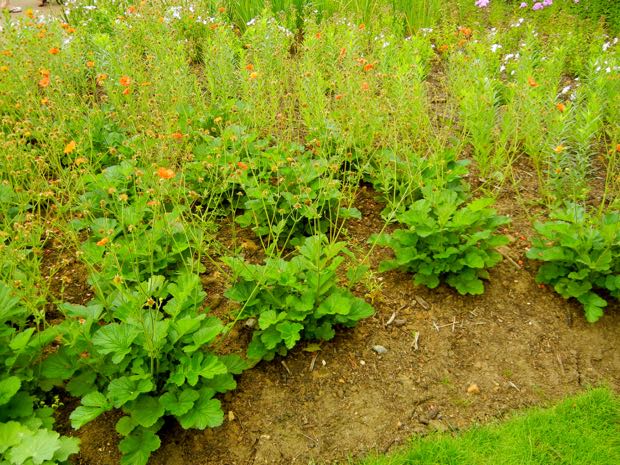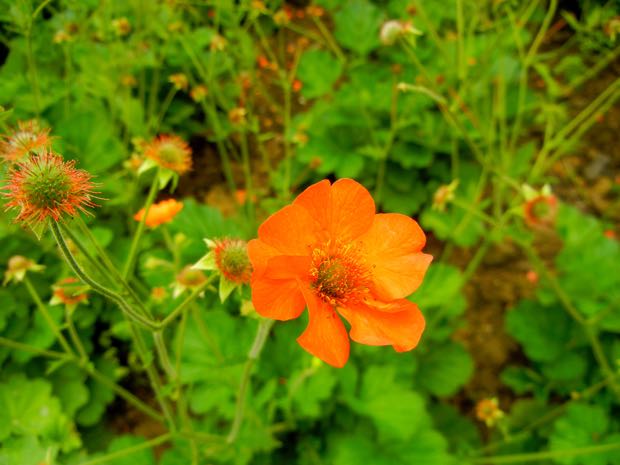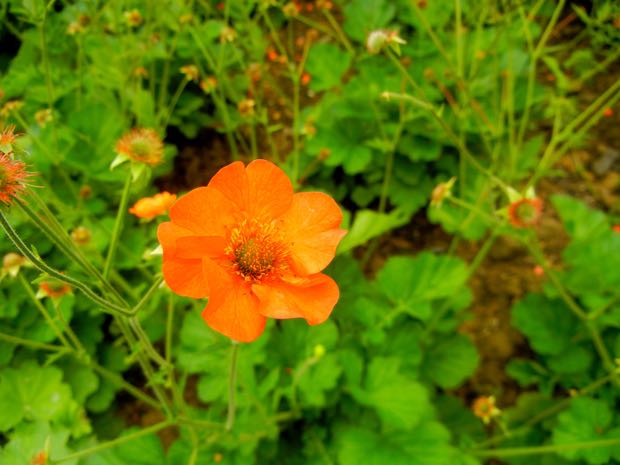Geum ‘Totally Tangerine’ – Adding a Splash of Color to Your Garden
Geum ‘Totally Tangerine’ also known as Avens ‘Totally Tangerine,’ is a stunning rhizomatous perennial belonging to the Rosaceae family. This cultivar, a deliberate cross between Geum rivale and Geum chiloense ‘Mrs. Bradshaw’ was created by Timothy Crowther in 1999 at his nursery in West Sussex, United Kingdom. Standing tall at around 90cm, this large Geum variety boasts vibrant orange flowers that grace the garden throughout the summer and fall seasons.
A Delightful Perennial Hybrid
Forming a clump of basal foliage reaching up to 14″ in height, Geum ‘Totally Tangerine’ showcases rough-textured, tomentose leaves. These medium green leaves, with biserrate margins, provide an evergreen to semi-evergreen presence in warmer winter climates. The upward and outward-facing flowers steal the show, displaying stunning orange-peach hues in branched sprays that tower above the foliage mound, reaching heights of 30″. While the flowers are sterile, lacking fruit or seed production, they offer a prolonged blooming period from mid-spring to mid-summer, with sporadic additional blooms occurring in late summer and early fall.
A Versatile Beauty for Your Garden
Geum ‘Totally Tangerine’ thrives as a clump-forming, herbaceous perennial, offering an abundance of peachy-orange flowers that add a bright splash of color to any sunny garden. With a height range of 12-30″ (30-75 cm) and a width of 18″ (45 cm), it provides a substantial presence. Plant this cultivar in moist, well-drained soil, ensuring it receives ample sunlight. For encouraging more flowers, cutting back the growth to the ground is beneficial. Geum ‘Totally Tangerine’ is particularly well-suited for borders, thanks to its vibrant colored flowers and clump-forming habit.
Easy Care and Adaptable
Growing Geum ‘Totally Tangerine’ is relatively straightforward. It thrives in medium moisture, well-drained soils under full sun to partial shade conditions. Moist and fertile soils are preferred, while wet and poorly drained soils in winter can be detrimental. In hot climates, especially those in USDA Zone 7 and below, providing some afternoon shade is recommended. Although this cultivar tends to struggle in the heat and humidity of the deep South, it exhibits evergreen foliage in southern climates.
A Garden Favorite for Wildlife
Geum ‘Totally Tangerine’ is not only a visual delight but also a magnet for butterflies, hummingbirds, and bees. Its bright blooms and attractive foliage make it a favorite among these garden visitors. Additionally, its deer and rabbit-resistant nature adds to its appeal.
Cultivation of Geum ‘Totally Tangerine’:
Planting and Soil Requirements: Geum ‘Totally Tangerine’ thrives in average, medium moisture, and well-drained soils. It prefers soil that is moist and fertile. When selecting a planting location, choose an area that receives full sun to partial shade. In hotter climates, providing some afternoon shade can help protect the plant from excessive heat. Prepare the soil by loosening it and incorporating organic matter to improve drainage and fertility.
Watering Needs: Proper watering is essential for the health and growth of Geum ‘Totally Tangerine.’ While it prefers moist soil, be cautious not to overwater and create waterlogged conditions. Water the plant deeply and consistently, especially during dry spells and the establishment period. Monitor the moisture levels in the soil and adjust the watering frequency accordingly.
Fertilization: Geum ‘Totally Tangerine’ generally does not require frequent fertilization. However, applying a light application of balanced fertilizer in the spring can promote vigorous growth and abundant flowering. Use a slow-release or organic fertilizer and follow the manufacturer’s instructions for application rates.

Pruning and Deadheading:
To encourage continuous blooming, remove spent flower stems promptly. Deadheading not only keeps the plant tidy but also stimulates the production of new flowers. As the flowering season comes to an end, consider cutting back the plant to the ground. This practice promotes fresh growth and prepares the plant for the following growing season.
Division and Propagation: Geum ‘Totally Tangerine’ can be propagated through division, which is best done in spring or fall. Carefully lift the plant from the ground and divide it into two or more sections, ensuring each division has a healthy root system. Replant the divisions in prepared beds, water them well, and provide appropriate care to encourage their establishment.
Pest and Disease Management: Geum ‘Totally Tangerine’ is generally not prone to severe pest or disease problems. However, like many plants, it may occasionally encounter sawfly larvae. Keep an eye out for any signs of pest infestation and take appropriate measures, such as handpicking the larvae or using organic insecticides if necessary. Proper sanitation and good air circulation around the plant can help prevent diseases such as powdery mildew.
Winter Care:
In regions with cold winters, Geum ‘Totally Tangerine’ benefits from winter protection. Apply a layer of mulch around the base of the plant to insulate the roots and protect them from frost damage. This is particularly important in areas where the temperatures drop significantly. In warmer climates, the foliage may remain evergreen or semi-evergreen, but it is still advisable to provide some winter care to ensure the plant’s overall health.
A Flourishing Garden Gem
With its vibrant orange flowers, hardy nature, and easy care requirements, Geum ‘Totally Tangerine’ is an excellent choice for perennial borders, butterfly gardens, rock gardens, cottage gardens, and even containers. Its adaptability makes it a versatile addition to any garden,





